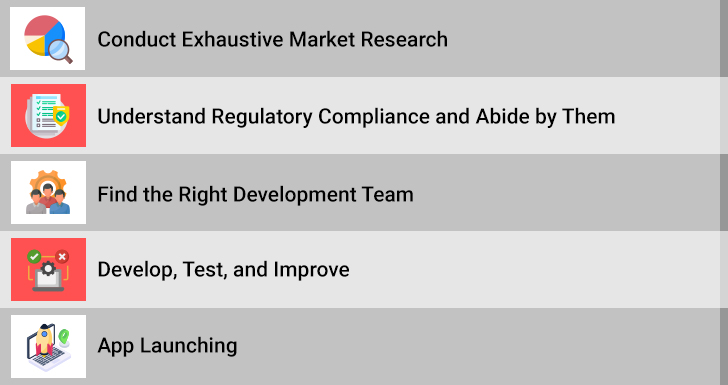In the realm of digitization, many industries have witnessed a paradigm shift, and the FinTech industry is no different. Until a few years ago, investment management used to be nerve-wracking and required agents, brokers, specialized training, and whatnot. However, the advent of FinTech applications has made investing so simple that Gen Z and Millennials can manage it without breaking a sweat. All they need is just a smartphone and an investment management application.
The investment management application is perceived as a lucrative business idea for startup founders, serial entrepreneurs, product managers, or established enterprises. The reason behind this is the widespread prevalence of micro-investing over the last few years. According to a recent report, nearly 145 million people, or 56% of adults are investing in the stock market in the United States alone. Besides adults, passive income is also luring the millennial generation and it is showing a great interest in investing and trading. A recent survey reveals that 64% of millennials are prioritizing investing over paying down debt to achieve financial freedom and retire comfortably. Furthermore, grandparents, these days are giving their grandchildren FAANG or MAMAA stocks as a birthday present. This indicates that Nasdaq-100 has huge growth potential and that’s why the demand for investment applications has been surging with every passing year.

Considering the existing demand and the future growth rate, investment application development is on the cards among the C-suite audience. However, before embarking on the bandwagon, read this ultimate guide on how to succeed in the development and build popular investment management applications like Acorns, Robinhood, E*TRADE, Betterment, Bank of America (BoA), Capital One, Vanguard, and more. Let’s dig deeper into it.
Types of Investment Management Apps
Deciding on investment management application development is a tough row to hoe since there is a plethora of options available. It’s considered wise to do exhaustive research on the application type beforehand since based on the type of application, businesses need to determine the required features and decide on the tech stack, team size, engagement models, etc. Primarily, there are four types of investment management applications.
1. Banking Apps
In this digital-driven world, everything has shifted to mobile and banking is no different. With banking applications, users can access a complete suite of services offered by licensed financial institutions such as fund transfer, balance inquiry, bill payment, investment management, personal & business loans, and more. Some popular examples of banking apps include Bank of America, Ally Bank, Capital One, and Wells Fargo.
2. Investment Apps
These applications simplify the investing journey of retail investors by offering them a digital platform to make smart investment decisions. Also, some investment applications offer educational materials like research reports, articles, news updates, etc. that help users to acquire insights about the listed companies before taking positions in them. Acorns, Betterment, and Invstr are some popular examples of investment apps.
3. Stock Trading Apps
As the name suggests, stock trading applications allow users to buy and sell stocks on either delivery or intraday and build their investment portfolios. Stock exchange trading applications are the most profitable ones from the business standpoint since enterprises can earn from users by levying charges on physical delivery of derivatives, equity brokerage, F&O brokerage, auto square-off, account maintenance charges (AMC), etc. Robinhood, E-Trade, and Webull are some popular examples of stock trading applications.
4. Investment Tracking Apps
They tend to streamline the investments done by users. In other words, investment tracking applications are ideal for multi-asset tracking since they allow users to track all their investments made in cryptocurrencies, exchange-traded funds (ETFs), bonds, forex, and more from a single platform. Delta is one such all-in-one investment tracker used by retailer investors in the United States.
7 Key Lessons for FinTech Solutions Providers
Cost of Developing an Investment Management Application
On average, the cost of developing an investment management application varies from $50,000 to $100,000. However, the actual development cost depends on a slew of factors such as app type, complexity, features, integrations, tech stack, team size, and location of the development team. Amidst all, the development team and the team location are the critical factors that influence the development cost. To understand this better, below is a complete breakdown of the cost based on the type of development team and team location.
Investment App Development Cost Based on the Type of Team
The cost of an investment management application with minimum viable features is based on 1600 development hours.
| Team | Cost in USD |
|---|---|
| US local team | 250,000 |
| In-house team | 200,000 |
| Freelancers | 45,000 |
| Outsourcing agency | 65,000 |
From the table, it is clear that partnering with an outsourcing agency for investment app development gives SMBs the advantage of having an in-house team at the cost of onboarding developers from the freelance marketplace platforms.
Investment App Development Cost Based on the Team Location
The cost of an investment application highly depends on the location from where developers are onboarded. Below is a complete overview of the pricing of an investment application when developers are hired from six different regions.
| Location | Average Cost in USD |
|---|---|
| The US | 250,000 |
| The UK | 200,000 |
| Australia | 180,000 |
| Western Europe | 120,000 |
| Eastern Europe | 65,000 |
| South Asia | 45,000 |
Get an Estimate for Investment App Development
Steps to Follow When Building an Investment Management Application
Developing a user-friendly and fully-functional investment management application requires following a structured approach. Listed below are the steps that need to be followed to build a successful investment application.

Step 1: Conduct Exhaustive Market Research
First things first – before taking any action, conduct extensive market research to analyze the latest trends in the market. Also, try to understand the persona of the target audience, their income level, age group, place of residence, needs and pain points, and more. This will help in integrating relevant features into the application to address customers’ challenges.
Step 2: Understand Regulatory Compliance and Abide by Them
Before starting the development process, it becomes imperative to understand the regulatory compliance requirements of the region, wherein, enterprises are planning to conduct their business. Since an investment management application collects, processes, and stores sensitive data of users, it must comply with General Data Protection Regulation (GDPR) and other laws and regulations that vary across regions. For instance, developing an investment application in the United States requires the FinTech company to abide by the rules of the Federal Trade Commission (FTC), whereas, in the United Kingdom, the Financial Conduct Authority (FCA) approval is required.
Step 3: Find the Right Development Team
It is one of the critical steps that determine the success of an investment management application. When it comes to hiring app developers, there are several options available such as establishing an in-house team, hiring freelancers, or outsourcing the project to an offshore agency. Amongst all, outsourcing is the best option since it saves enterprises from the hassle of investing time in recruiting and onboarding the right application development team. The aforementioned is a chart that depicts that outsourcing allows enterprises to enjoy the benefits of having an in-house development team at a fractional cost, which is equivalent to hiring freelancers. When outsourcing the application development project to an outsourcing agency, it is important to make sure that the offshore agency has a team that is adept at the below-listed tech stack:
| Aspect | Required Tech Stack |
|---|---|
| Programming Languages/Frameworks | Java and Kotlin for Android app developmentSwift and Objective-C for iOS app developmentReact Native, Ionic, Flutter, Xamarin, and Apache Cordova for hybrid app development. |
| Backend Development | Django, LAMP, ExpressJS, Laravel |
| Database Management | MongoDB, MySQL, Amazon RDS, IBM DB2 |
| UI/UX Design | Balsamiq, Principle, Figma |
| Product Management | Confluent, Jira Software |
| Hosting | AWS, Google Cloud, Azure |
Step 4: Develop, Test, and Improve
Begin the investment app development with bare minimum features, and then keep adding more functionality later on. In other words, kickstart the development process with an MVP to bring out the best version of an investment management application. Since application development is a time-intensive process, it is important to ensure that the outsourcing agency has divided the entire app development process into different sprints and in each sprint, developers are continuously improving the app functionality, while QA engineers test the same to find bugs.
Step 5: App Launching
The final stage of investment app development is deployment. Once the investment application is ready-to-use, it will be released to popular platforms such as App Store (iOS), Google Play (Android), and more.
The Key Takeaway
The Global Fintech Market is estimated to grow at a CAGR of 26.2% during 2022-2030. With the growing market demand, it seems viable to consider an investment management application development. To build successful investment applications like Acorns, Betterment, and Invstr, you should partner with a reliable application development company having a sizable portfolio of delivering Fintech projects successfully. At Damco Solutions, we are backed by a seasoned team of certified engineers who have worked on several Fintech projects including Banking Application Development, P2P Lending Platforms, Wealth Management Platforms, Digital and Mobile Payment Solutions, Neo Banking Platforms, Trading Platforms, Equity Platforms, and many more.





